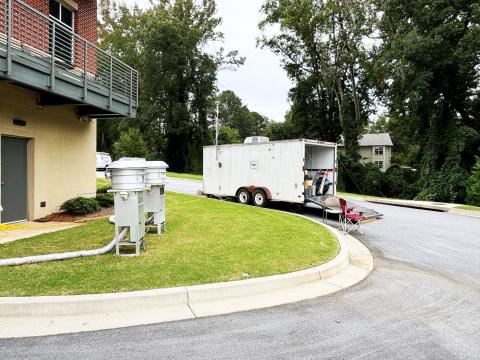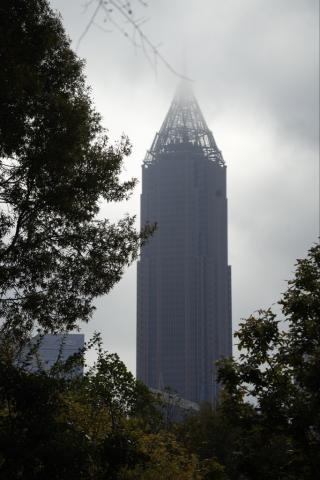Led by School of Earth and Atmospheric Sciences Professor Greg Huey, the NSF RAPID grant is for analyzing air chemistry data collected during a three-week span when a chemical plume impacted the Atlanta area.
On September 29, 2024, a chemical plume of chlorine- and bromine-containing compounds spread across the Atlanta area. The result of a fire at the BioLab pool chemical manufacturing facility in Conyers, Georgia, the plume impacted communities for several weeks, prompting a stay-at-home order and the temporary evacuation of approximately 17,000 people for the surrounding county.
Professor Greg Huey has been awarded an NSF RAPID grant to unravel the chemical composition of the emission plumes. The grant, "Identification and Measurement of Emissions from the Biolab Incident Impacting the Atlanta Urban Area", will support the analysis of air chemistry data collected during a three-week span that the plume impacted the Atlanta area.
During the incident, Huey’s lab collected real-time air chemistry data in two locations — at Georgia Tech in Midtown Atlanta, and near the BioLab facility, in Conyers, GA.
Huey, a professor in the School of Earth and Atmospheric Sciences, has spent the last fifteen years measuring halogens — including chlorine and bromine — in remote locations like Barrow, Alaska. “Normally, there are no halogens detectable in the Atlanta area,” he says. “But spending the last 15 years making observations in other locations means that we were well-equipped to measure the halogens from the BioLab plume, and untangle some of the plume’s chemistry.”
“Our goal is to understand and report what was in the plume, then establish a website and make the data publicly available,” Huey adds. “We aim to share valuable public knowledge about this incident.”
A rapid response
When the plume first became visible, Huey recognized the ability to collect data in real-time.
“We decided to turn our high resolution mass spectrometer on and start sampling air,” he says. This piece of scientific equipment is capable of capturing and identifying chemical signatures, and is sensitive to measuring levels of specific chemicals, such as chlorine and bromine. “We have a port measure on the roof of our building at Georgia Tech, which allowed us to start observing the first day,” he adds.
However, this kind of data collection also depends on wind direction blowing chemicals to different regions, Huey explains.
Leveraging the School of Earth and Atmospheric Sciences’ mobile air quality trailer, the team deployed a second mass spectrometer near the BioLab facility in Conyers, Georgia. “The City was very supportive,” Huey shares. “We set up the mobile lab in the parking lot of Conyers City Hall with the goal of seeing what we could measure — and if we were seeing high levels of chlorine.”
With both sites established, Huey says the team was able to simultaneously measure in Conyers and in Midtown Atlanta — and began to see that the plume was more chemically complex than initially thought.
A proactive approach
Collected data in tow, the NSF RAPID grant will support Huey and a graduate student in the analysis of those site readings, including calibration and publication of chemical data — to be archived to a publicly accessible site; analysis of mass spectra associated with the plumes and identification of chemical compounds; calibration of the species identified, prioritized based on toxicity; and publication of a report on all species detected in the plumes.
Data from the project will help inform communities potentially impacted by the plume — while helping predict the impacts of similar chemical incidents, enabling a better understanding of how to address accidental chemical emissions in the future.
“We want to have a better idea of what this type of incident can produce for future incidents, and we want to have a better idea of what people may have been exposed to,” Huey says. “While we can’t measure and identify everything, this project will help us become better informed for the future.”
Funding:
NSF AGS Division of Atmospheric and Geospace Sciences #2509330
Additional Images

<p>The School of Earth and Atmospheric Sciences' air quality trailer in Conyers, Georgia (<em>Photo Credit: Greg Huey Research Group</em>)</p>

<p>Mass spectrometry equipment (Photo Credit: Greg Huey Research Group)</p>
